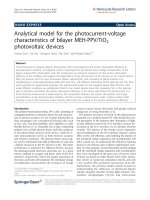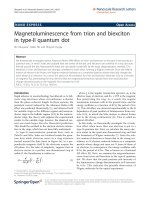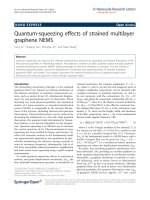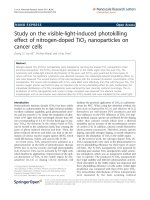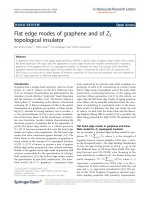Okuyama et al. Nanoscale Research Letters 2011, 6:351 doc
Bạn đang xem bản rút gọn của tài liệu. Xem và tải ngay bản đầy đủ của tài liệu tại đây (614.77 KB, 6 trang )
NANO EXPRESS Open Access
Magnetoluminescence from trion and biexciton
in type-II quantum dot
Rin Okuyama
*
, Mikio Eto and Hiroyuki Hyuga
Abstract
We theoretically investigate optical Aharonov-Bohm (AB) effects on trion and biexciton in the type-II semiconductor
quantum dots, in which holes are localized near the center of the dot, and electrons are confined in a ring structure
formed around the dot. Many-particle states are calculated numerically by the exact diagonalization method. Two
electrons in trion and biexciton are strongly correlated to each other, forming a Wigner mole cule. Since the relative
motion of electrons are frozen, the Wigner molecule behaves as a composite particle whose mass and charges are
twice those of an electron. As a result, the period of AB oscillation for trion and biexciton becomes h/2e as a function
of magnetic flux penetrating the ring. We find that the magnetoluminescence spectra from trion and biexciton
change discontinuously as the magnetic flux increases by h/2e.
PACS: 71.35.Ji, 73.21 b, 73.21.La, 78.67.Hc
Introduction
Rapid advance in nanotechnology has allowed us to fab-
ricate ring structures whose circumference is shorter
than the phase coherent length. In these systems, the
persistent current induced by the Aharonov-Bohm (AB)
effect was predicted theoretical ly [1], and observed both
for metallic rings in the diffusive regime and semicon-
ductor rings in the ballistic regime [2,3]. In the semicon-
ductor rings, the theory well explains the experimental
results. In the metallic rings, however, the observed cur-
rent was much larger than the theoretical prediction.
This should be ascribed to the electron-electron interac-
tion in the rings, which has not been fully understood.
In type-II semiconductor quantum dots, such as
ZnSeTe and SiGe, holes are localized inside the quan-
tum dots while electrons move in a ring structure
formed around the dots (inset in Figure 1a). In a per-
pendicular magnetic field B, the electrons acquire the
AB phase. For the sake of simplicity, suppose that an
electron moves in a perfect one-dimensional ring of
radius R, the Hamiltonian is written as
H =
¯
h
2
2m
e
R
2
ˆ
L −
h/e
2
,
(1)
where
ˆ
L
is the angular momentum operator, m
e
is the
effective mass of electron, and F= π R
2
B is the magnetic
flux penetrating the ring. As a result, the angular
momentum increases with in the ground state, and the
energy oscillates as a function of F by the period of h/e
[1]. This AB effect was observed experimentally as the B
dependence of peak position of luminescence from exci-
tons [4,5], in which the hole motion is almost frozen
due to the strong confinement [6]. T his is called an
optical AB effect.
In this study, we theoretica lly investigate the correla-
tion effect when more than one electron is put in a
type-II quantum dot. First, we calculate the many-elec-
tron states in the quasi-one-dimensional ring and find
the formation of Wigner molecules [7]. Since the rela-
tive motion of electrons is frozen due to the strong cor-
relation, an N-electron molecule behaves as a composite
particle whose charge and mass are N times of those of
an electron. In consequence, the energy oscillates with
F by the period of h/Ne. This is known as a fractional
AB effect [8]. Next, we examine the magnetolumines-
cence from trion and biexciton in the type-II quantum
dot. We show that the peak position and intensity of
the luminescence change discontin uously as F increases
by h/2e. This indicates the possible observation of
Wigner molecules by the optical experiment.
* Correspondence:
Faculty of Science and Technology, Keio University, 3-14-1 Hiyoshi, Kohoku-
ku, Yokohama 223-8522, Japan
Okuyama et al. Nanoscale Research Letters 2011, 6:351
/>© 2011 Okuyama et al; license e Springer. This is an Open Access article distributed under the terms of the Creative Commons
Attribution License ( s/by/2.0), which permits unrestricte d use, distribution, and reproduction in
any medium, provided the original work is properly cited.
Model and calculation method
We consider a type-II semiconductor quantum dot
formed in a plane. A ring-like potential
V
e
(r)=m
e
ω
2
e
r
2
/2 + V
0
exp(−αr
2
)
is imposed on elec-
trons, while a harmonic potential
V
h
(r)=m
h
ω
2
h
r
2
/
2
on
holes. Here, m
e
and m
h
are the effective masses of el ec-
trons and holes, respectively. A magnetic field is applied
perpendicularly to the quantum dot.
Parameters ω
e
, ω
h
, V
0
,anda are chosen so that R,at
which V
e
(r) has the minimum, is eight times larger than
Figure 1 Low-lying energies for (a) one, (b) two, and (c) three electrons in the type-II quantum dot, as a function of the magnetic flux
F. The dot radius R equals to the effective Bohr radius a
B
=4πħ
2
/m
e
e
2
. Solid and dash lines indicate spin-singlet and triplet, respectively, in (b),
whereas they indicate quartet and doublet in (c). The period of AB oscillation becomes h/Ne for N electrons.
Okuyama et al. Nanoscale Research Letters 2011, 6:351
/>Page 2 of 6
the size of hole confinement
¯
h/m
h
ω
h
. The expectation
value of the electron radius is approximately R in our
model.
Using the field operator for electron,
ˆ
ψ
e,σ
(
r
)
,andfor
hole,
ˆ
ψ
h,σ
(
r
)
, the effective mass Hamiltonian is written as
H =
j=e,h;σ =↑,↓
d
2
r
ˆ
ψ
†
j,σ
(r)
1
2m
j
[−i
¯
h∇−q
j
A(r)]
2
+ V
j
(r)
ˆ
ψ
j,σ
(r
)
+
1
2
j,σ ,σ
∫
d
2
rd
2
r
ˆ
ψ
†
j,σ
(r)
ˆ
ψ
†
j,σ
(r
)
e
2
4πε|r − r
|
ˆ
ψ
j,σ
(r
)
ˆ
ψ
j,σ
(r)
+
σ
,
σ
∫
d
2
rd
2
r
ˆ
ψ
†
e,σ
(r)
ˆ
ψ
†
h,σ
(r
)
−e
2
4πε|r − r
|
ˆ
ψ
h,σ
(r
)
ˆ
ψ
e,σ
(r),
(2)
where q
e
=-e, q
h
= e, and A(r) is the vector potential;
∇ × A =-Be
z
. Note that the exchange interaction
between electron and hole is omitted here for the fol-
lowing reason. An electron [hole] wave function Ψ
e
(r)
[Ψ
h
(r)] is written as
e
(
r
)
= ψ
e
(
r
)
u
c
(
r
),
(3)
h
(r)=ψ
h
(r)u
∗
v
(r)
,
(4)
where ψ
e
(r)[ψ
h
(r)] is an envelope function for an
electron [hole] state, and u
c
(r)[u
v
(r)] is the Bloch func-
tion of the conduction [valence] band edge. u
c
(r) and u
v
(r) mainly consist of s- and p-waves, respectively. Since
they oscillate in space by the p eriod of t he lattice con-
stant, a, the exchange interaction between electron and
hole is smaller by the order of (a/R)
2
than other terms,
e.g., the exchange interaction between two electrons.
The strength of the magnetic field is measured by F =
πR
2
B, the f lux penetrating the rin g of radius R.The
strength of the Coulomb potential against the kinetic
energy increases with R/a
B
,wherea
B
=4πħ
2
/m
e
e
2
is
the effective Bohr radius. R/a
B
≳ 1intheexperimental
situations [4,5].
The exact diagonalization method is used t o take full
account of the Coulomb interaction. We calculate the
luminescence spectra by the dipole approximation, using
obtained energies and wavefunctions of many-body
states.
Results and discussion
Few electrons without hole
First, we cal culate the electronic states in the absence of
holes. Figure 1 shows F depe ndence of low -lying ener-
gies for (a) one, (b) two, and (c) three electrons confined
in V
e
(r)withR/a
B
= 1. The total angular momentum L
is indicated in the figure. For one electron, the angular
momentum increases by one in the ground state F as
increases by about h/e, and the energy oscillates quasi-
periodically with F.bytheperiodofh/e. This suggests
that the electronic confinement V
e
(r) realizes a quasi-
one-dimensional electron ring. In contrast to the pe rfect
one-dimensional ring, on the other hand, a diamagnetic
shift is seen in our model. As a whole, the energy
increases with F.Thisisbecausetheelectronradiusis
shrunk by the magnetic field. For two and three elec-
trons, the angular momentum incre ases, and the energy
oscillates quasi-periodically with F in the ground state.
The diamagnetic shift is also present. However, the per-
iod of AB oscillation becomes about h/Ne for N
electrons.
In order to elucidate the relation between the elec-
tron-electron interaction and the fractional period of AB
oscillation, we examine many-body states for two elec-
trons with changing R/a
B
.Figure2showslow-lying
energies with (a) R = a
B
= 0.01, (b) 0.1, (c) 1, and (d)
10. Without the Coulomb interaction, two electrons
occupy the lowest orbital shown in Figure 1a in the
ground state. Consequently, the total angular momen-
tum is always even, and the total spin is a singlet. As
the strength of the Coulomb interaction increases with
R/a
B
, the exchang e interac tion lowers energies for spin-
triplet states compared to sing let states. For R/a
B
≳ 1,
singlet and triplet states alternatively appear as F
increases by about h/2e. Hence, the g round-state energy
oscillates with F by the period of h/2e.Notethatthe
period of AB oscillation in the case of R/a
B
=10is
slightly shorter than that of R/a
B
= 1. This is because
the Coulomb repulsion between electrons tends to
increase the expectation value of the electron radius.
We calculate the two-body density
ρ(r|r
0
)=
1
2
σ ,σ
0
ˆ
ψ
†
e,σ
(r)
ˆ
ψ
†
e,σ
0
(r
0
)
ˆ
ψ
e,σ
0
(r
0
)
ˆ
ψ
e,σ
(r)
,
(5)
to examine the electric correlati on. Figure 3 shows the
two-body density for the two-electron ground state at zero
magnetic field with ( a) R/a
B
= 0.01, (b) 0.1, (c) 1, and (d)
10. r
0
is fixed at (R, 0), which is indicated by a circle in the
plots. For R/a
B
≳ 1, electrons maxi mize t heir distance to
be localized at the other side in the ring, that is, a Wigner
molecule is formed. Since the relative motion of electrons
is frozen, the Wigner molecule behaves as a composite
particle whose mass and charge are twice those of an elec-
tron. I n consequence the ground-state e nergy oscillates
with F by the period of about h/2e.
Similarly, three electrons are loca lized at apice s of an
equilateral triangle inscribed in the ring to form a
Wigner molecule. The per iod of AB oscillation in the
ground-state energy becomes about h/3e for R/a
B
≳ 1.
The total spin S of the ground state changes with L,as
shown in Figur es 1 and 2. For two electrons, S =1(S =
0) when L is even (odd). In the case of three electrons, S
=3/2ifL is a multiple of 3, S = 1/2 otherwise. This is
explained by the N-fold rotational symmetry of the elec-
tron configuration in the Wigner molecule [9].
Okuyama et al. Nanoscale Research Letters 2011, 6:351
/>Page 3 of 6
Electron-hole complex and optical spectrum
Next, we investigate electron-hole complexes: exciton,
trion, and biexciton. We fix R/a
B
=1.Sincethehole
motion is almost frozen due to the strong confinement
in the quantum dot, the F dependence of the ground
state of exciton is qualitatively the same as that of an
electron confined in V
e
(r). In the same manner, the F
dependence of the ground state of trion and biexciton
mimics that of two electrons [10]. In particular, two
electrons in trion or biexciton form a Wigner molecule,
Figure 2 Low-lying energies for two electrons in the ty pe-II quantum dot, as a function of the magnetic flux F. Solid and dash lines
indicate spin-singlet and triplet, respectively. The ratio of the dot radius R to the effective Bohr radius a
B
=4πħ
2
/m
e
e
2
is (a) 0.01, (b) 0.1, (c) 1,
and (d) 10. The ground-state energy oscillates by the period of h/2e for R/a
B
≳ 1.
Okuyama et al. Nanoscale Research Letters 2011, 6:351
/>Page 4 of 6
and the period of AB oscillation in the ground-state
energy becomes a bout h/2e as a function of F for trion
and biexciton [10].
We examine r ecombination phenomena. Figure 4
shows the F dependence of the luminescence peak from
(a) exciton and (b) trion. The behavior of the biexciton
peak is qualitatively the same as in Figure 4b. The exciton
peak oscillates by the period of about h/e.Ontheother
hand, the trion peak increases with an increase in F and
suddenly drops by the period of about h/2e.Thefrac-
tional period of h/2e comes from the period of AB oscil-
lation in the ground state of trion. The discontinuous
change is explained by a selection rule for the recombina-
tion: The optical transition co nserves the orbital angular
momentum in two-dimensional s ystems [11]. A trion
with the angular moment um L has to decay into an elec-
tron with the same angular momentum. As a result, both
of the initial and final states of the recombination chang e
at the transition of the trion state. In the case of exciton
recombination, the final state is always the vacuum state
of the quantum dot, and the peak position is continuous
as a function of F,asseeninFigure4a(Therecombina-
tion of e xciton with the angular momentum L ≠ 0isfor-
bidden by a selection rule. After the first transition of the
electronic state at F ≄ h/2e, excitons get dark in our
model. However the forbidden transitions wer e observed
in experiments. This should be a scribed to the disorder
of samples which breaks the selection rule.)
Figure 5 shows the intensity of the trion peak as a
function of F. The intensity of the biexciton peak is
approximately the same. The intensity decreases discon-
tinuously at the transit ion of the electronic state, and
approximately takes a constant value until the next tran-
sition occurs. Roughly speaking, the height of the
Figure 3 Gray scale plots of the two-body density for the two-
electron ground state at zero magnetic field with (a) R/a
B
=
0.01, (b) 0.1, (c) 1, and (d) 10. One electron is fixed at the point
indicated by a circle.
Figure 4 The luminescence peaks from (a) exciton and (b) trion
in the type-II semiconductor quantum dot, as a function of the
magnetic flux F. The trion peak suddenly drops as F increases by
h/2e.
Figure 5 The intensity of the trion luminescence peak as a
function of the magnetic flux F. Reflecting the two-electron
wave function, the intensity decreases discontinuously as F
increases by h /2e.
Okuyama et al. Nanoscale Research Letters 2011, 6:351
/>Page 5 of 6
intensity plate aus indicates a ratio of 4:3:1:0. The inten-
sity reflects properties of the two-electron wavefunction.
This is in good agreement with our the ory based on the
Heitler-Londo n approximation, in which the correlation
effect between ele ctrons is taken into account by a lin-
ear combination of two Slater determinants [10].
Conclusions
We have examined the optical AB effect on trion and
biexciton in the type-II semiconductor quantum dots.
We have found that two electrons in trion and biexciton
form a Wigner molecule. As a result, the ground-state
energy oscillates as a function of the magnetic flux by
the period of about h/2e. We have shown that the lumi-
nescence spectra from them change discontinuously as
the magnetic flux increases by about h/2e. This indicates
the possible observation of Wigner molecules by the
optical experiment.
We note that the discontinuous change in the lumi-
nescence peaks and intensity stems from the selection
rule, which is broken in the presence of dis order. By the
selection rule, exc itons with the angular momentum L ≠
0 should be dark. However, transitions from excitons
with finite L were observed by experiments in both
ZnSeTe and SiGe [4,5]. Possibly, the sudden change of
the luminescence spectra would be smeared in such sys-
tems. However, the fractional period of h/2e is a
ground-state property and hence, it is expected to be
observed even in dirty samples.
Abbreviations
AB: Aharonov-Bohm.
Acknowledgements
This work was partly supported by a Grant-in-Aid for Scientific Research from
the Japan Society for the Promotion of Science. R. O. was funded by
Institutional Program for Young Researcher Oversea Visits from the Japan
Society for the Promotion of Science.
Authors’ contributions
RO developed the numerical model, ran the simulation and acquired data.
The interpretation of data has been carried out together with RO and ME.
ME and HH conceived of the study and participated in its design and
coordination.
Competing interests
The authors declare that they have no competing interests.
Received: 15 August 2010 Accepted: 20 April 2011
Published: 20 April 2011
References
1. Bütiker M, Imry Y, Landauer R: “Josephson behavior in small normal one-
dimensional rings”. Phys Lett A 1983, 96:365.
2. Lévy LP, Dolan G, Dunsmuir J, Bouchiat H: “Magnetization of mesoscopic
copper rings: Evidence for persistent currents”. Phys Rev Lett 1990,
64:2074.
3. Mailly D, Chapelier C, Benoit A: “Experimental observation of persistent
currents in GaAs-AlGaAs single loop”. Phys Rev Lett 1993, 70:2020.
4. Sellers IR, Whiteside VR, Kuskovsky IL, Govorov AO, McCombe BD:
“Aharonov-Bohm Excitons at Elevated Temperatures in Type-II ZnTe/
ZnSe Quantum Dots”. Phys Rev Lett 2008, 100:136405.
5. Miyamoto S, Moutanabbir O, Ishikawa T, Eto M, Haller EE, Sawano K,
Shiraki Y, Itoh KM: “Excitonic Aharonov-Bohm Effect in Isotopically Pure
70
Ge/Si Self-Assembled Type-II Quantum Dots”. Phys Rev B 2010,
82:073306.
6. Kusukovsky IL, MacDonald W, Govorov AO, Mourokh L, Wei X, Tamargo MC,
Tadic M, Peeters FM: “Optical Aharonov-Bohm effect in stacked type-II
quantum dots”. Phys Rev B 2007, 76:035342.
7. Manninen M, Koskinen M, Reimann SM, Mottelson B: “Magnetic properties
of quantum dots and rings”. Eur Phys J D 2001, 16:381.
8. Yu N, Fowler M: “Persistent current of a Hubbard ring threaded with a
magnetic flux”. Phys Rev B 1992, 45:11795.
9. Liu YM, Bao CG, Shi TY: “Few-electron quantum rings in a magnetic field:
Ground-state properties”. Phys Rev B 2006, 73:113313.
10. Okuyama R, Eto M, Hyuga H: “Optical Aharonov-Bohm Effect on Wigner
Molecules in Type-II Semiconductor Quantum Dots”. arXiv:1103.4921 2011,
(accepted for publication in Phys Rev B).
11. Kalameitsev AB, Kovalev VM, Govorov AO: “Magnetoexcitons in type-II
quantum dots”. JETP Lett 1998, 68:669.
doi:10.1186/1556-276X-6-351
Cite this article as: Okuyama et al.: Magnetoluminescence from trion
and biexciton in type-II quantum dot. Nanoscale Research Letters 2011
6:351.
Submit your manuscript to a
journal and benefi t from:
7 Convenient online submission
7 Rigorous peer review
7 Immediate publication on acceptance
7 Open access: articles freely available online
7 High visibility within the fi eld
7 Retaining the copyright to your article
Submit your next manuscript at 7 springeropen.com
Okuyama et al. Nanoscale Research Letters 2011, 6:351
/>Page 6 of 6


